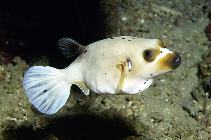| Family: |
Tetraodontidae (Puffers), subfamily: Tetraodontinae |
| Max. size: |
33 cm TL (male/unsexed) |
| Environment: |
reef-associated; marine; depth range 0 - 60 m |
| Distribution: |
Indo-Pacific: East Africa to Micronesia and Samoa, north to southern Japan, south to New South Wales. Replaced by Arothron diadematus in the Red Sea (Ref. 37816, Ref. 84159). |
| Diagnosis: |
Dorsal spines (total): 0-0; Dorsal soft rays (total): 10-11; Anal spines: 0-0; Anal soft rays: 10-12. Body covered with prickles (Ref. 559) and with large black spots (Ref. 4919).
Description: Characterized further by having variable pattern, often pale grey with dark patches around eye and on snout; top of snout with white bar across; widely scattered black spots; sometimes with little amount of yellow color on head and body; small spinules on head and body except around mouth, caudal peduncle and variable area of back, more developed spinules on ventral surface; short snout, length 2.0-2.5 in head length; rounded caudal fin, length 3.0-4.0 in SL (Ref. 90102). |
| Biology: |
Inhabit coastal to outer reef crest and slopes with rich invertebrate growth. Sometimes solitary (Ref. 90102). Adults often in pairs (Ref. 48637). Feed on corals (usually Acropora tips), crustaceans, mollusks, sponges, tunicates and algae (Ref. 2334). Generally common (Ref. 9710). |
| IUCN Red List Status: |
Least Concern (LC); Date assessed: 07 June 2011 Ref. (130435)
|
| Threat to humans: |
poisonous to eat |
Source and more info: www.fishbase.org. For personal, classroom, and other internal use only. Not for publication.
